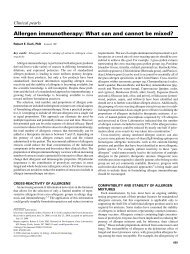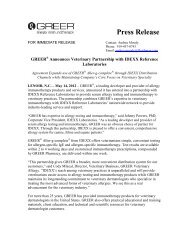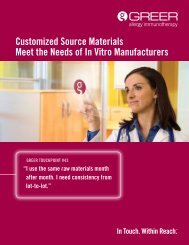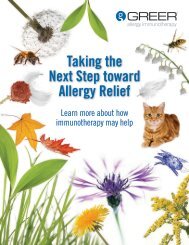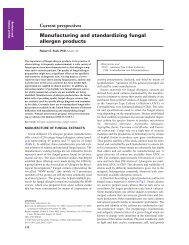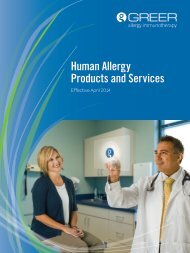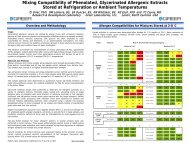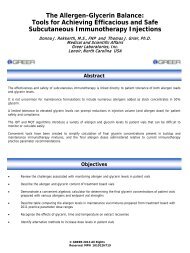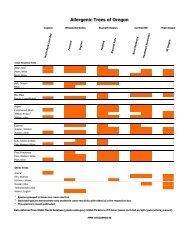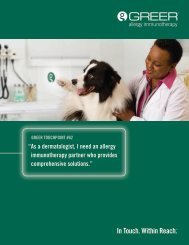allergenic extracts pollens, molds epidermals, insects dusts ... - Greer
allergenic extracts pollens, molds epidermals, insects dusts ... - Greer
allergenic extracts pollens, molds epidermals, insects dusts ... - Greer
Create successful ePaper yourself
Turn your PDF publications into a flip-book with our unique Google optimized e-Paper software.
1% glycerosaline solution. As a positive control, use glycerinated histamine phosphate<br />
diluted to 0.5 mg/mL (0.18 mg/mL histamine base) or aqueous histamine phosphate<br />
0.275 mg/mL (0.1 mg/mL histamine base).<br />
b. Patients tested only by the intradermal method:<br />
Since highly reactive individuals may react intracutaneously at 1:1 million or even<br />
1:10 million dilutions, any intradermal injection should be preceded by a puncture test<br />
and the dose adjusted accordingly. Other patients suspected of being moderately<br />
allergic should be tested with 0.02 to 0.05 mL of an appropriate extract dilution on the<br />
order of 1/10,000 to 1/100,000 of the concentrate. A negative test should be followed<br />
by repeat tests using progressively stronger ten-fold concentrations until significant<br />
wheal and flare reaction sizes are attained, or until skin test responses with the higher<br />
concentrations remain negative. As a negative control, use the diluent or, in the case of<br />
<strong>extracts</strong> in 50% glycerin, use 0.5% to 1% glycerosaline solution. As a positive control,<br />
use glycerinated histamine phosphate diluted to 0.5 mg/mL (0.18 mg/mL histamine<br />
base) or aqueous histamine phosphate 0.275 mg/mL (0.1 mg/mL histamine base).<br />
Skin tests are graded in terms of the wheal and erythema response noted at 15 to<br />
20 minutes, and compared to the appropriate controls. Wheal and erythema sizes may<br />
be recorded by actual measurement.<br />
2. IMMUNOTHERAPY<br />
Immunotherapy is administered by subcutaneous injection. Dosage of Allergenic<br />
Extracts is individualized according to the patient's sensitivity, the clinical response, and<br />
tolerance to the extract administered during the phases of an injection regimen. The<br />
initial dose of the extract should be determined based on the puncture test reactivity. In<br />
patients who appear to be exquisitely sensitive by history and skin test, the initial dose<br />
of the extract should be 0.05 to 0.1 mL of a low concentration, such as dilution number<br />
5 or 6 in below. Patients with lesser sensitivity may be started with 0.05 to 0.1 mL of the<br />
next higher concentration. The amount of Allergenic Extract is increased at each<br />
injection by no more than 50% of the previous amount, and the next increment is<br />
governed by the response to the last injection. Large local reactions which persist for<br />
longer than 24 hours are generally considered an indication for repeating the previous<br />
dose or reducing the dose at the next administration. Any evidence of systemic reaction<br />
is an indication for a reduction of 75% in the subsequent dose. The upper limits of<br />
dosage have not been established; however, doses larger than 0.2 mL of an extract in<br />
50% glycerin may cause discomfort upon injection. The dosage of Allergenic Extract<br />
does not vary significantly with the allergic disease under treatment.<br />
To prepare dilutions starting from a concentrate such as 1:10 W/V, 1:20 W/V, OR<br />
20,000 PNU/mL, proceed as in Table 1 below. (Note: Add 0.5 mL of concentrate to<br />
4.5 mL of sterile diluent and make additional dilutions in the same manner.)



